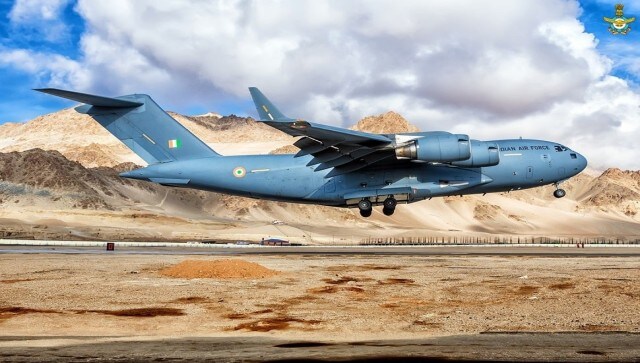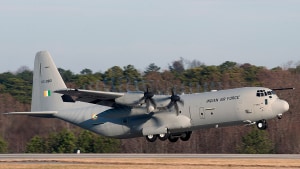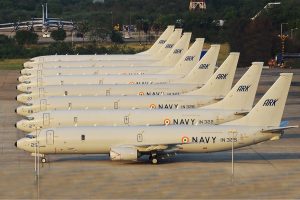www.firstpost.com/opinion/how-military-aviation-is-the-greatest-beneficiary-of-indo-us-relations-push-12728372.html
How military aviation is the greatest beneficiary of Indo-US relations push
The US needs India to counter-balance China, dominate the Indian Ocean, and act as a democratic pillar. The future will see greater defence cooperation between the two largest and most powerful democracies
Air Marshal Anil Chopra June 12, 2023 19:00:33 IST
Boeing C 17 Globemaster. Image Courtesy: IAF
Yet another major step is being taken to boost the India-US strategic relations. The two sides have cleared the decks for co-producing the GE-F414 fighter aircraft engine in India. It will go on-board India’s indigenous LCA ‘Tejas’ Mk II and other future fighters. The formal signing is likely during Indian PM Modi’s US visit later this month. It is
expected to involve 100 percent transfer of technology (ToT).
The United States contingent at this year’s Aero India 2023 was one of the largest ever. For the
first time a fifth-generation aircraft had not only been brought to an Indian airshow but also performed the flying display. The U.S. defence sales in the last over a decade have mostly been in the military aviation sector. Having already sold transport aircraft and helicopters, the pitch now is to push an American fighter and other technologies and components into the Indian defence ecosystem.
Complexities of an aero-engine
WATCH: Indigenously developed torpedo successfully engages underwater target
The aircraft engine is one of the most complex systems on-board. It has to operate efficiently from sea level to near stratosphere levels, under changing atmospheric pressure. The aircraft operate from zero speed to many times the speed of sound. The fighter aircraft are subjected to very high ‘g’ forces, and aerobatic maneuvers including negative ‘g’ flight. The aircraft engine compressor and turbines operate at many thousand revolutions per minute (RPM). The engine turbine temperatures cross 2,000 degree centigrade. All this requires very special design and materials. The engine life could be a few thousand hours of operation.
More often the aircraft engine costs nearly one-third the total cost of the aircraft. The aircraft engine is much more complex than the rocket engines that launch satellites into space.
Engine for LCA
India’s Defence Research and Development Organisation’s (DRDO) Gas Turbine Research Establishment (GTRE) has been struggling to make aero-engine for nearly four decades. The home-grown ‘Kaveri’ engine which was to power the LCA had to be delinked from the aircraft because of developmental delays and technology hurdles. Finally the American GE F404-GE-IN20 was selected to power the LCA Mk 1 and Mk 1A. Later it was decided to have the more powerful GE F414 – INS6 engine for LCA Mk II. This may also power the initial Indian fifth-generation Advanced Medium Combat Aircraft (AMCA).
Top aero engine manufacturers
There are just a handful of aircraft engine manufacturers in the world. The top four engine manufacturers are GE Aviation, Pratt & Whitney, Rolls Royce, & Safran.
GE and Safran of France have a joint venture (JV) called CFM International. Pratt & Whitney also has a JV called International Aero Engines with Japanese Aeroengine Corporation and MTU Aero Engines of Germany. Pratt & Whitney and General Electric have a JV, Engine Alliance selling a range of engines for large airliners like Airbus 380. There are others like Honeywell Aerospace which make smaller engines for regional/executive jets and UAVs. Most engine manufacturers make engines for both civil and military aircraft. Russia makes both fighter and large transport aircraft engines, but depends on Western companies for their airliner engines. China has been trying to reverse engineer Russian jet engines, but they continue to face hurdles. They too use Western engines for their civil aircraft. India has been manufacturing and overhauling Russian and Western fighter engines under license agreements.
Criticality of aero-engine technology for India
Over the last few decades, India has mastered designing and building aero-structures for both fixed wing and rotary wing aircraft. India is also manufacturing airborne radars, avionics and weapons. The aero-engine being much more complex and despite years of licensed production, India has not been able to successfully design one of its own. The
handful of manufacturers keep their cards very close to the chest and are unwilling to share technologies that they have acquired after years of research and investment. The only easy way to get these is through JV. Such engine JVs are normally between geo-strategic friends and involve political capital investment. To what level will the technology be actually transferred would emerge after the fine-print is read.
US-India strategic congruence and Quad connection
The US interests to contain competitor and possible rival China brought India into USA’s Indo-Pacific strategy. India, a long-term friend of now weakened Russia,
needed US cooperation on global security matters; support for inclusion of India in United Nations Security Council (UNSC); and admission into multilateral export control regimes like Nuclear Suppliers Group, MTCR, Wassenaar Arrangement, and Australia Group. Post 2000, the USA became more open to selling high-end military equipment to India. In 2016, India and USA signed the Logistics Exchange Memorandum of Agreement (LEMOA) and India was declared a major defence partner of the USA. In September 2018 India and USA signed the Communications Compatibility and Security Agreement (COMCASA), thus increasing interoperability between militaries. The agreement allows India to procure and transfer specialized equipment for encrypted communications for US origin military platforms, thus improving operational efficiency. Basic Exchange and Cooperation Agreement, the last of the key foundational agreements was signed in 2020.
India is an important member of Quad now. All the four partners have regular summit level and 2+2 minister level meetings. There are military logistics agreements between all, and they all take part in regular military exercises. Among the increasing cooperation in
defence, aviation has seen the fastest results.
C 130 J super Hercules. Image Source: IAF
US military aircraft in India
IAF acquired the Lockheed Martin (LM) C-130J-30 Super Hercules aircraft in 2008 for special operations under US government’s Foreign Military Sales (FMS) program. The Indian Navy received the Boeing P-8I Poseidon for maritime surveillance, Electronic Intelligence (ELINT), anti-submarine warfare (ASW) roles. In 2009, the IAF inducted three specially equipped Boeing 737 Business Jet (BBJ) for VVIP duties. Boeing C-17 Globemaster III strategic airlift military transport aircraft were inducted next. Two custom-made B-777 were procured to replace the older Air India B-747 jumbo jets for VVIP duties. Boeing Apache Longbow AH-64E attack helicopters, and Boeing CH-47 D/F Chinook heavy-lift helicopters formed the rotary-wing purchases. In June 2017, the US State Department approved the sale of 22 General Atomics MQ-9 Guardian/Predator-B long-range unmanned combat aerial vehicle (UCAV) drones to India. Two have been on lease with the Indian Navy since 2020. The case for procuring 10 each for the three armed forces is under processing. There is a possibility that a contract may be inked during the Indian PM’s forthcoming visit.
Boeing presence in India
Boeing has been a major player in India’s commercial aviation sector, and Air India has recently announced a huge airliner order. Boeing also has a significant presence in aforesaid military aircraft. Boeing’s F-18 Super hornet is vying for IAF (114 fighter program) and Indian Navy’s (57 carrier aircraft) contracts.
A public-private partnership brings together Boeing, Hindustan Aeronautics (HAL) and Mahindra’s global scale, manufacturing and supply chain expertise.
HAL has been the single-source producer of 757 over-wing exit doors. HAL has also manufactured the 777 up-lock boxes, F/A-18 gun bay doors, F/A-18 wire harnesses, P-8I weapons bay doors, and P-8I identification friend-or-foe transponders. BEL is also on contract to provide F/A-18 cockpit panels.
Boeing has invested in research and engineering centres at Bengaluru and Chennai with over 3,000 engineers. Boeing’s JV with Tata Advanced Systems Limited (TASL) is for aerospace and defence manufacturing including unmanned aerial systems. TASL is already manufacturing aero-structures for CH-47 Chinook and Apache helicopters, including for global customers.
Indian Navy’s Boeing P8 I. Image Source: Indian Navy
Dynamatic Technologies (DTL) and Boeing have a plant to manufacture critical parts for Chinook helicopters, including ramp and pylons. Dynamatic Technologies and Tata Advanced Materials Limited (TAML) are making P-8I electric power sub-systems. Also, Bharat Electronics Limited (BEL), Electronics Corporation of India (ECIL), Hyderabad based Avantel Ltd have delivered sub-systems for P-8I.
Along with TAL Manufacturing Solutions Ltd Boeing is manufacturing floor beams for the Boeing 787-9 Dreamliner. TAL also makes ground support equipment for the C-17. Hyderabad-based Cyient currently provides design support on the 747-8 Freighter and some 787 variants.
Lockheed Martin pushing big in India
LM is the world’s biggest arms manufacturer, and manufacturer of top fighter aircraft like the F-16, F-22 and F-35. Their JV with TASL makes a large number of aero-structures and precision components for the C-130J airlifter and the S-92 helicopter for deliveries to customers around the world.
LM F-21 aircraft (advanced version of F-16) is a contender for IAF’s Multi-Role Fighter Aircraft (MRFA) program. 2250 F-16s are still flying globally. TASL has been chosen to produce the F-16s in India. Meanwhile,
F-16 wings are being manufactured and exported from the Hyderabad facility. 24 Sikorsky multi-role MH-60R Seahawk maritime helicopters are under induction with the Indian Navy. Additionally, LM has signed MoUs with many Indian start-ups to boost India’s aerospace and defence industry.
Indian Navy’s Sikorsky MH-60 R Seahawk. Image: Indian Navy
General Electric (GE)
GE is an American multinational that operates in aviation, healthcare, renewable energy, and transportation, among many others.
GE’s presence in India dates back to 1902 when they installed India’s first hydropower plant. GE Aviation is the world’s leading producer of large and small engines for commercial, military, business and general aircraft. GE’s aircraft engines power all the LCA variants.
GE’s CFM56 engines power the Indian Navy’s P-8I. Some of GE systems are deployed on various Indian platforms including the Hawk Mk 132, SEPECAT Jaguar, P-8I, C130J and HJT-36 Sitara. GE has joined with Tata group to make LEAP engines in India.
Military exercises and interoperability
The Indian and US armies regularly conduct exercise ‘Yudh-Abhyas’. USA, India, Japan, and some other navies participate in the annual exercise ‘Malabar’. Rim of the Pacific Exercise (RIMPAC) covers the broad expanse of the Indo-Pacific. ‘Cope India’ series of joint air exercises began in 2004. IAF participates in Red-Flag advanced air-combat training exercises in the US, and gets exposure to NATO-like air environment. The USA had great presence in the recent Pitch Black air-exercise in Australia where many countries fielded F-35s. All these exercises support interoperability.
Defence Technology and Trade Initiative (DTTI)
The India US Defence Technology and Trade Initiative (DTTI) began in 2012. DTTI supports and strengthens India’s defence industrial base, including exploring new areas of technological development. Among the ambitious projects identified was to share jet-engine technology. Focus is to support Indian start-ups and US-based research labs to work together on cutting edge defence technologies. Also explore possibilities for joint development with export potential. Cooperation in the field of space technology is also of interest.
Defence trade authorization and management
The
United States has designated India as Strategic Trade Authorization-1 (STA-1) country that allows purchase of cutting-edge sensitive technologies from the USA. It brings India at par with the US’s closest allies and partners such as NATO, Japan, South Korea and Australia. India will thus receive license-free access to the wide range of dual-use technologies, with some export restrictions. This will also benefit US manufacturers. The US-India Business Council (USIBC) was formed in 1975. Aerospace & Defence are a major area of their engagement today. Bilateral defence trade which was near zero in 2008, was estimated to be around $22 billion by the end of 2022.
The India-US Defence Policy Group (DPG) in Washington is the top official-level meeting mechanism between India and the US on defence issues, which comprehensively reviews and guides all aspects of bilateral cooperation between the two countries. They monitor defence cooperation, technology, trade, and military-to-military engagements under different working groups.
Defence partnerships: The way ahead
India and the USA are the largest functioning democracies. There is very high people-to-people engagement with Indians occupying very high positions in most American corporations. The Indian diaspora has popularised Indian food, culture and festivals. Military-to-military engagements are on the rise and so is defence cooperation. Being a significant global power, India would like to maintain strategic autonomy. India will continue to be dependent on Russian military supplies for some more time. The USA is conscious of the ground realities.
Having already got into India’s transport and maritime aircraft, and helicopter sales ecosystem, the
US is now keen to sell fighter aircraft. India also needs to get out of the huge Russian military systems basket, including aircraft. In the long-term India must induct more Indian platforms, and endeavour to have
30 per cent Russian, 30 per cent Western and 40 per cent Indian aircraft fleets by 2040. 114 foreign fighters may be one of the last major foreign aircraft purchases. India must take US support to make high-end airborne platforms in India. Aircraft engines are one such area. India must link the fighter aircraft selection to both Make-in-India and transfer of important technologies.
The USA has also been pushing for the Boeing KC-46 Flight Refuelling Aircraft (FRA). They are trying to strengthen the case that they will offer both ‘flying boom’ and ‘probe and drogue’ refuelling options, that are today required for India’s diverse fleets. The General Atomics Predator drones deal is expected to be inked soon, albeit with reduced numbers.
India is today in an enviable position where the Russians, Americans and Europeans are wooing her to be a geo-strategic partner, and also trying to get into its defence systems market. The US needs India to counter-balance China, dominate the Indian Ocean, and act as a democratic pillar. The future sees greater defence cooperation between the two largest and powerful democracies.
The writer is Director General, Centre for Air Power Studies. Views expressed are personal.





